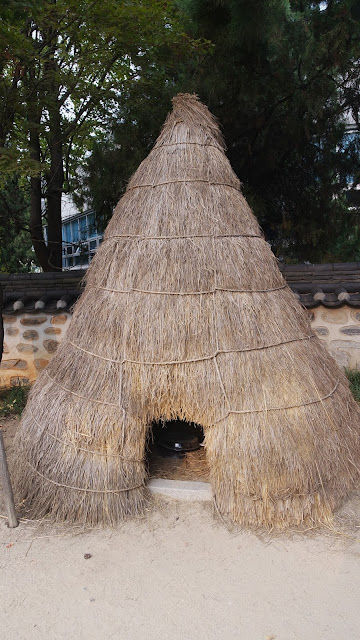Kimchi is the most famous side dish in Korea. Especially, most families do Kimjang (making Baechu-Kimchi) between late Nov and early Dec for winter. Each family has its own native flavor of Kimchi as cheese in western countries. It was hard to get vegetables in winter thus it was stored in a big jar under the earth. Nowadays a Kimchi refrigerator is used.
Baechu-kimchi is made by fermenting brined Korean cabbage with Korean radish, vegetables, salt-fermented seafood, ground red pepper and various seasonings. Kimchi is a quintessential side dish that is served without fail on dining tables in Korea. Kimchi was approved as an International Standard Food by Codex in 2001. Certain studies have shown a link between kimchi and cancer prevention.
1. Ingredients and Preparation
a. Trim the bottom and outer
leaves of the cabbage, put a deep knife slit lengthwise and split it
into two parts by hands, marinate them in salt water in which half of the
coarse salt dissolved, and spread remained half of the salt in between the
petioles. Let it sit cutting side up for 3 hours, and then another 3 hours after
turn over.
b. Rinse the cabbage under running water for 3~4 times, drain water on a tray for about 1 hour.
c. Trim and wash the radish, shred into 5cm-long, 0.3cm-wide/thick. Trim and wash watercress stalks, small green onion and mustard leaf, cut them into 4cm-long.
b. Rinse the cabbage under running water for 3~4 times, drain water on a tray for about 1 hour.
c. Trim and wash the radish, shred into 5cm-long, 0.3cm-wide/thick. Trim and wash watercress stalks, small green onion and mustard leaf, cut them into 4cm-long.
d. Place onions, pears, and apples with water cooled after boiled with kelps and radishes into blender contaiomer after cutting them, and then blend until smooth.
e. Wash fresh shrimps softly.
f. Mince the solid ingredients of salted shrimps finely. Soak ground red pepper in the salted shrimps juice and salted anchovy juice.
f. Mince the solid ingredients of salted shrimps finely. Soak ground red pepper in the salted shrimps juice and salted anchovy juice.
2. Recipe
a. Add soaked red pepper to the shred radish, mix well, add remained seasonings, and mix well again. Add vegetables, oyster or fresh shrimps, and ground onions, pears, and apples mix softly and season with salt.
b. Pack the seasonings in between each leaf of the cabbage, fold over the outer leaves to hold the seasonings.
c. Place it in a jar one by one until 70~80% of the jar or the Kimchi contationer for a refrigerator filled, cover the top with marinated outer leaves.
4. Make Kimchi liquid by adding some water and salt into the Kimchi mixing container. Then finish by pouring Kimchi liquid into the jar or the Kimchi contationer for a refrigerator and pressing down.
b. Pack the seasonings in between each leaf of the cabbage, fold over the outer leaves to hold the seasonings.
c. Place it in a jar one by one until 70~80% of the jar or the Kimchi contationer for a refrigerator filled, cover the top with marinated outer leaves.
4. Make Kimchi liquid by adding some water and salt into the Kimchi mixing container. Then finish by pouring Kimchi liquid into the jar or the Kimchi contationer for a refrigerator and pressing down.


3. When to Eat
After well fermented (around 1 month later), Kimchi is laid upon the table. The best flaver is a little bit sour because of lactic acid bacteria.
Thanks to development of special Kimchi refriugerator, we can enjoy the Kimjang Kimchi all the year round. Of course, there are lots of fresh cabbages all the year round but late autumn cabbages are the most favorable for Kimchi. Especially old Kimchi is the best for the stew with Kimchi and Pork.
* Most of explanation and one picture are copied from website of Korea Tourism Organization (http://english.visitkorea.or.kr/enu/FO/FO_EN_Recipes.jsp?gotoPage=3&cid=1042665&cat1=21709&cat2=21733).















댓글 없음:
댓글 쓰기